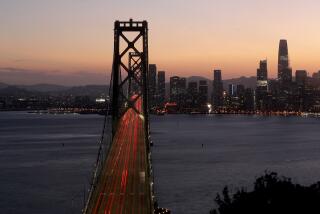Editorial: Proposed environmental rules could help cities reduce car use
California is about to overhaul the way it measures the impact of new residential and commercial development on transportation, revising the metrics in a manner that is expected to make it easier to build in cities and harder to expand the suburbs.
Last year, Gov. Jerry Brown signed a bill by Sen. Darrell Steinberg (D-Sacramento) that was primarily designed to expedite the Sacramento Kings arena project, but that also directed the state to develop alternative methods of measuring transportation impacts under the California Environmental Quality Act. Under the previous CEQA process, a project is deemed to have a negative environmental impact if it would slow traffic. Under the proposed rules, a project would have a negative impact if it increased the number of cars on the road or created longer trips.
That may not sound like a big difference, but it is. The current “level-of-service” model was part of California’s traditional car-centric approach, encouraging sprawl and working as a perverse disincentive for biking, walking and mass transit. If you’re measuring transportation impacts based only on how quickly cars can move, every mitigation measure will be geared toward moving cars fast. That has meant adding more lanes, synchronizing traffic lights so cars don’t have to slow down at intersections, and other steps, all of which create uninviting or dangerous streets for cyclists and walkers. Plus, when motorists can drive faster, they are more likely to drive more often and for longer distances, avoiding alternative modes of transportation and creating more greenhouse gases. The goal shouldn’t be to slow traffic to a crawl, but to encourage more travel options.
By contrast, if you’re measuring the transportation impact of a building project based on the number and distance of car trips it would generate, the mitigation measures will be geared toward reducing the need or desire to drive. That could mean providing transit passes to employees, offering bicycle lockers or charging for parking. The proposed guidelines suggest that projects built within half a mile of rail stations or high-frequency bus stops may even be exempt from lengthy transportation studies and shielded from transportation challenges under CEQA that could stop or slow development.
In theory, this is an important and smart change in California’s landmark environmental law. In practice, the state must ensure that the rules don’t ignore the facts on the ground. Just because a proposed development is located near a rail station or a high-frequency bus stop doesn’t necessarily mean residents or workers will use their cars less or take mass transit or create fewer greenhouse gases. Los Angeles is full of neighborhoods with bus or subway stops, yet fewer than 5% of the residents in those neighborhoods use public transportation. Transit-adjacent development shouldn’t get a free pass. Cities should have the flexibility under CEQA guidelines to require that urban developments reduce car trips and deliver on the goal of reducing greenhouse gas emissions.
Follow the Opinion section on Twitter @latimesopinion
More to Read
A cure for the common opinion
Get thought-provoking perspectives with our weekly newsletter.
You may occasionally receive promotional content from the Los Angeles Times.






